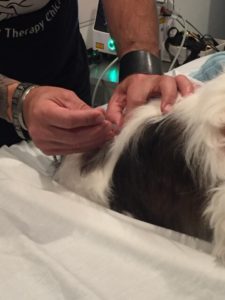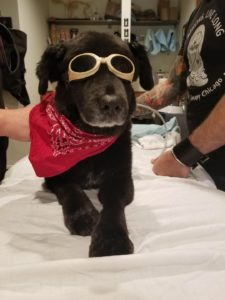I took Max to ARFIT after I had taken him to the vet. He wasn’t able to move his back legs. The vet had suggested surgery but, with Max’s heart murmur, I needed to find an alternative. That when I called ARFIT. When I brought Max in, Tod told us what was going on and gave us hope that Max was going to walk again. After a couple of sessions, I saw a difference in Max. He was standing and giving a few steps. Now Max is no longer dragging himself. He is walking and running around. He is so much happier. I’m very grateful that Tod didn’t give up on Max, and that he is walking again.”
~Mariana
What is a Spinal Stroke?
A Spinal Stroke or Fibrocartilaginous embolism occurs when a piece of the vertebral disc breaks off and impedes blood flow to neurons in the spinal cord. When the blood flow to neurons in the spinal cord get cut off, the neurons die resulting in leg paralysis.
What are the symptoms of a spinal stroke?
The specific symptoms and severity of a spinal stroke (FCE) depend on the level of the spinal cord affected and how much of the cord is damaged.
In some cases, the symptoms will appear suddenly and in other cases paralysis will occur hours after the stroke happened. Symptoms include:
- Sudden and severe neck or back pain
- Muscle weakness in the front and / or hind legs
- bowel and bladder (incontinence)
- muscle spasming
- numbness in the extremities
- paralysis of the front and / or hind legs
Can Physical Therapy Help?
Yes. Initially, we focus on reducing soft tissue trauma and inflammation caused by the FCE as well as reducing the secondary effects of muscle spasming and weakness / difficulty standing and walking. By using Cold Laser Therapy, Dry Needling, Massage and Manual Therapy techniques we can improve mobility and reduce your pets’s discomfort. We will provide you with home care techniques and recommendations so you can improve your pet’s comfort and help speed up their recovery at home.
*Cold Laser Therapy for pain reduction and soft tissue healing
What Can I expect treatment to be like?
In the first 1-2 weeks, we focus on mobility and pain reduction. As your pet’s condition progresses, we gradually introduce range of motion therapies using manual stretching techniques, joint and soft tissue mobilization and proprioceptive / sensory and balance training. We will also progress home exercises as tolerated. Over the next several weeks, we will introduce higher level balance training for core strengthening and begin our unique incline treadmill weight training program created by Tod Miner. This program is customized for your pet and uses land based harness pull / resistance training instead of conventional water therapy.

Will my pet recover?
In most cases, (74% in recent studies) dogs will regain the use of their legs and no longer be incontinent. Physical Therapy may provide your pet with a better outcome and improved quality of life.
Ready to get started?
Complete our new client questionnaire, and we will contact you to schedule an initial evaluation.

